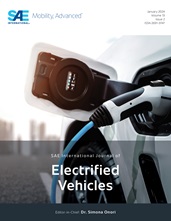Refining Control, Charging, and Battery Chemistry for CO 2 e Savings in Heavy-Duty Off-Road Plug-In Series Hybrid
- Features
- Content
- With current and future regulations continuing to drive reductions in carbon dioxide equivalent (CO2e) emissions in the on-road industry, the off-road industry is also likely to be regulated for fuel and CO2e savings. This work focuses on converting a heavy-duty off-road material handler from a conventional diesel powertrain to a plug-in series hybrid, achieving a 49% fuel reduction and 29% CO2e reduction via simulation. Control strategies were refined for energy savings, including a regenerative braking strategy to increase regenerative braking and a load-following hydraulic strategy to decrease electrical energy consumption. The load-following hydraulic control shuts off the hydraulic electric machine when it is not needed—an approach not previously seen in a load-sensing, pressure-compensated system. These strategies achieved a 24.1% fuel savings, resulting in total savings of 61% in fuel and 41% in CO2e in the plug-in series compared to the conventional machine. Beyond control strategies, this study evaluated battery chemistry and charging strategy refinements for total cost of ownership (TCO) and lifetime CO2e. LFP batteries emerged as the most cost-effective and least emitting due to their longer lifespan, which reduced replacement frequency. Charging comparisons showed that Level 2 charging (L2C) typically resulted in lower TCO but higher lifetime CO2e than DC fast charging (DCFC). DCFC costs were heavily influenced by local demand charges, and DCFC emissions were heavily influenced by local grid emissions.
- Pages
- 18
- Citation
- Goodenough, B., Czarnecki, A., Robinette, D., Worm, J. et al., "Refining Control, Charging, and Battery Chemistry for CO 2 e Savings in Heavy-Duty Off-Road Plug-In Series Hybrid," SAE Int. J. Elec. Veh. 14(2), 2025, https://doi.org/10.4271/14-14-02-0009.
